Benjamin Satchwell played an important part in the transformation of Leamington, from a small village into a thriving spa town. As a result, he was dubbed the ‘Father of Leamington Spa’ and has given his name to this Wetherspoon pub.
An illustration and text about The Benjamin Satchwell.
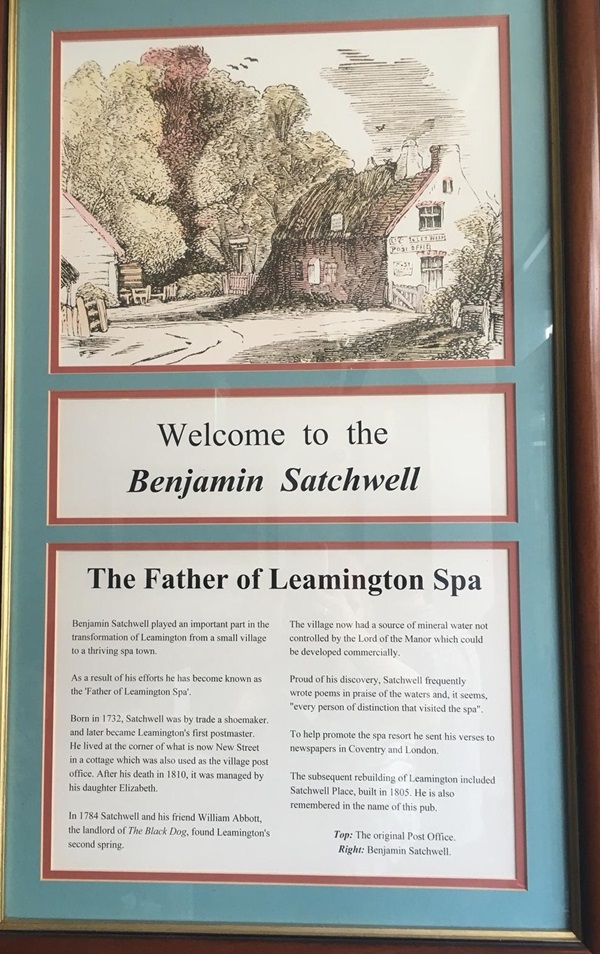

The text reads: Benjamin Satchwell played an important part in the transformation of Leamington from a small village to a thriving spa town.
As a result of his efforts he has become known as the `Father of Leamington Spa’.
Born in 1732, Satchwell was by trade a shoemaker, and later became Leamington’s first postmaster. He lived at the corner of what is now New Street in a cottage which was also used as the village post office. After his death in 1810, it was managed by his daughter Elizabeth.
In 1784 Satchwell and his friend William Abbott, the landlord of The Black Dog, found Leamington’s second spring.
The village how had a source of mineral water not controlled by the Lord of the Manor which could be developed commercially.
Proud of his discovery, Satchwell frequently wrote poems in praise of the waters and, it seems, “every person of distinction that visited the spa”.
To help promote the spa resort he sent his verses to newspapers in Coventry and London.
The subsequent rebuilding of Leamington included Satchwell Place, built in 1805. He is also remembered in the name of this pub.
Top: The original Post Office. Right: Benjamin Satchwell.
Illustrations and text about medical treatments.
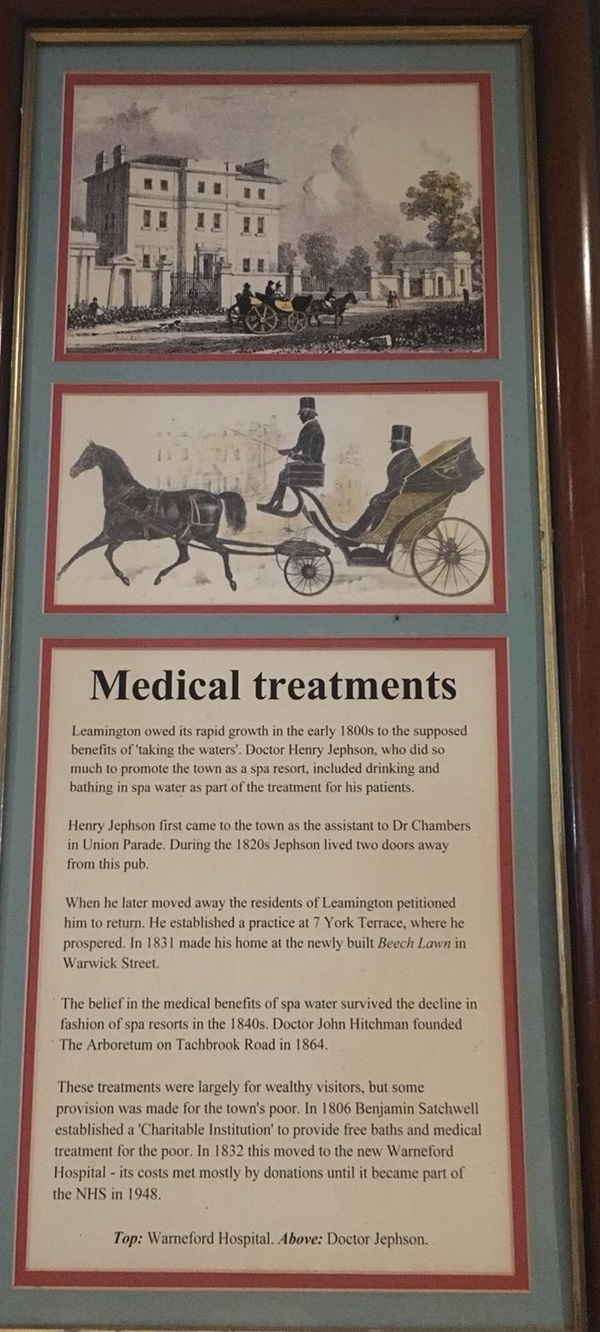
The text reads:
Leamington owed its rapid growth in the early 1800s to the supposed benefits of `taking the waters’. Doctor Henry Jephson, who did so much to promote the town as a spa resort, included drinking and bathing in spa water as part of the treatment for his patients.
Henry Jephson first came to the town as the assistant to Dr Chambers in Union Parade. During the 1820s Jephson lived two doors away from this pub.
When he later moved away the residents of Leamington petitioned him to return. He established a practice at 7 York Terrace, where he prospered. In 1831 made his home at the newly built Beech Lawn in Warwick Street.
The belief in the medical benefits of spa water survived the decline in fashion of spa resorts in the 1840s. Doctor John Hitchman founded The Arboretum on Tachbrook Road in 1864.
These treatments were largely for wealth visitors, but some provision was made for the town’s poor. In 1806 Benjamin Satchwell established a `Charitable Institution’ to provide free baths and medical treatment for the poor. In 1832 this moved to the new Warneford Hospital – its costs met mostly by donations until it became part of the NHS in 1948.
Top: Warneford Hospital
Above: Doctor Jephson.
Illustrations, prints and text about religion and education.
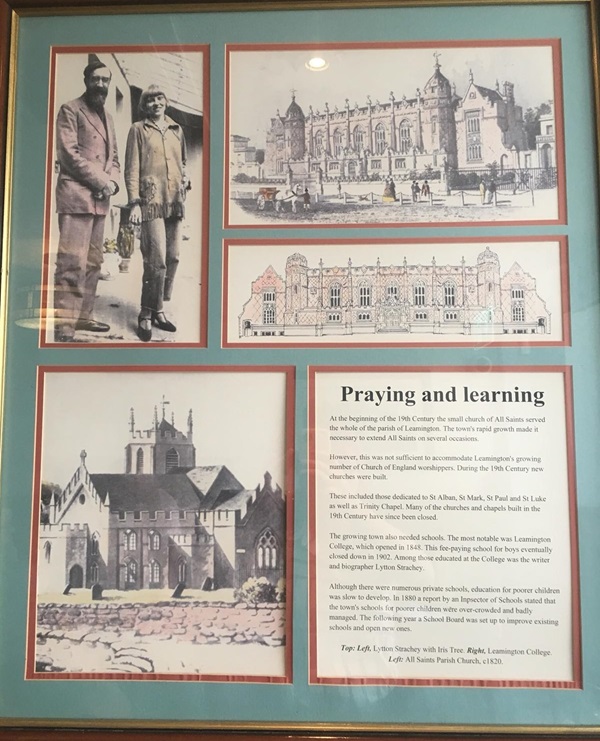
The text reads: At the beginning of the 19th century the small church of All Saints served the whole of the parish of Leamington. The town’s rapid growth made it necessary to extend All Saints on several occasions.
However, this was not sufficient to accommodate Leamington’s growing number of Church of England worshippers. During the 19th century new churches were built.
These included those dedicated to St Alban, St Mark, St Paul and St Luke as well as Trinity Chapel. Many of the churches and chapels built in the 19th century have since been closed.
The growing town also needed schools. The most notable was Leamington College, which opened in 1848. This fee-paying school for boys eventually closed down in 1902. Among those educated at the College was the writer and biographer Lytton Strachey.
Although there were numerous private schools, education for poorer children was slow to develop. In 1880 a report by an Inspector of Schools stated that the town’s schools for poorer children were over-crowded and badly managed. The following year a School Board was set up to improve existing schools and open new ones.
Top: Left, Lytton Strachey with Iris Tree, right, Leamington College
Left: All Saints Parish Church, 1820.
Prints and text about the history of Leamington Spa.
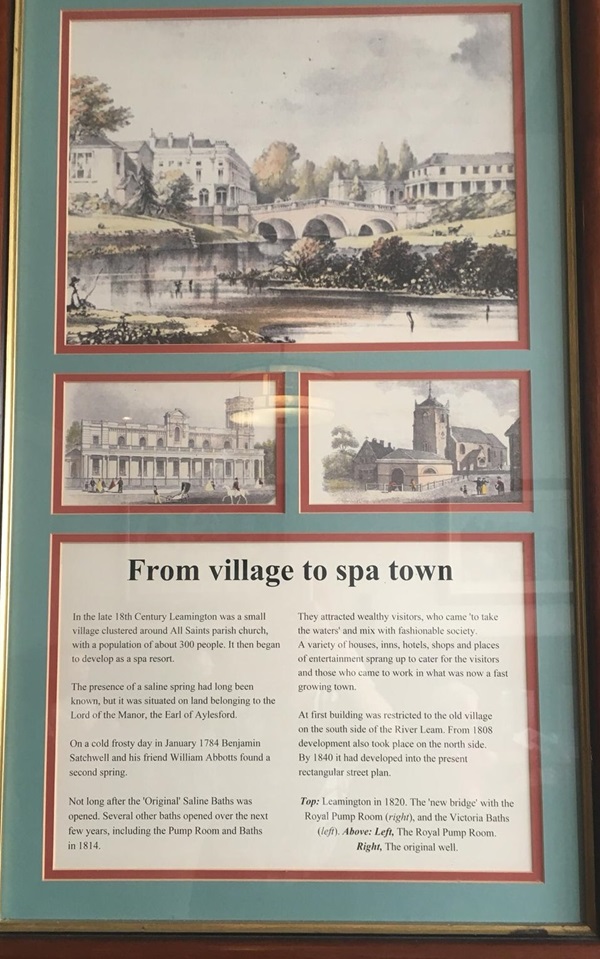
The text reads: In the late 18th century Leamington was a small village clustered around All Saints parish church, with a population of about 300 people. It then began to develop as a spa resort.
The presence of a saline spring had long been known, but it was situated on land belonging to the Lord of the Manor, the Earl of Aylesford.
On a cold frosty day in January 1784 Benjamin Satchwell and his friend William Abbotts found a second spring.
Not long after the `Original’ Saline Baths was opened. Several other baths opened over the next few years, including the Pump Room and Baths in 1814.
They attracted wealthy visitors, who came ‘to take the waters’ and mix with fashionable society. A variety of houses, inns, hotels, shops and places of entertainment sprang up to cater for the visitors and those who came to work in what was now a fast growing town.
At first building was restricted to the old village on the south side of the River Leam. From 1808 development also took place on the north side. By 1840 it had developed into the present rectangular street plan.
Top: Leamington in 1820. The `new bridge’ with the Royal Pump Room (right), and the Victoria Baths (left)
Above: Left, The Royal Pump Room
Right: The original well.
Illustrations and text about the Parade.
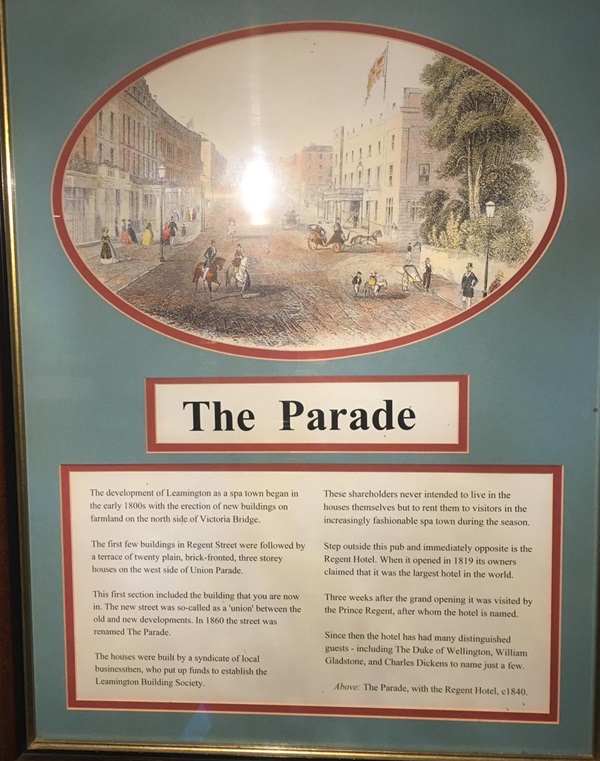
The text reads: The development of Leamington as a spa town began in the early 1800s with the erection of new buildings on farmland on the north side of Victoria Bridge.
The first few buildings in Regent Street were followed by a terrace of twenty plain, brick-fronted, three storey houses on the west side of Union Parade.
This first section included the building that you are now in. The new street was so-called as a `union’ between the old and new developments. In 1860 the street was renamed The Parade.
The houses were built by a syndicate of local businessmen, who put up funds to establish the Leamington Building Society.
These shareholders never intended to live in the houses themselves but to rent them to visitors in the increasingly fashionable spa town during the season.
Step outside this pub and immediately opposite is the Regent Hotel. When it opened in 1819 its owners claimed that it was the largest hotel in the world.
Three weeks after the grand opening it was visited by the Prince Regent, after whom the hotel is named.
Since then the hotel had had many distinguished guests – including The Duke of Wellington, William Gladstone, and Charles Dickens to name just a few.
Above: The Parade, with the Regent Hotel, 1840.
A photograph of the Bandstand, Pumproom Gardens, Leamington Spa 1906.
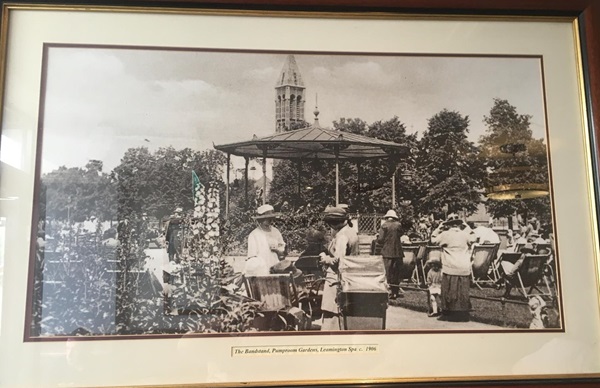
A photograph of Spencer Street, Leamington Spa 1930.
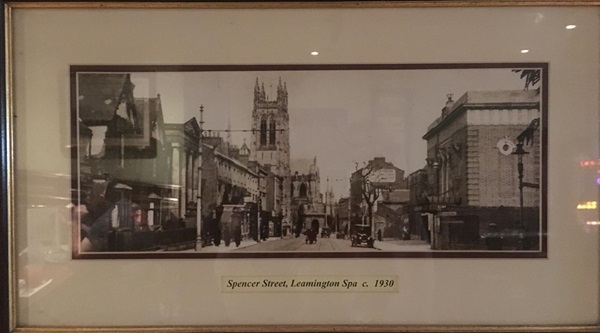
A photograph of Beauchamp Avenue, Leamington Spa 1906.
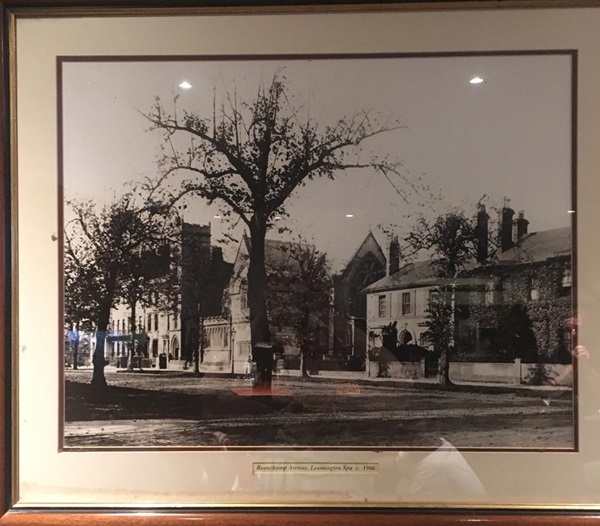
External photograph of the building – main entrance.
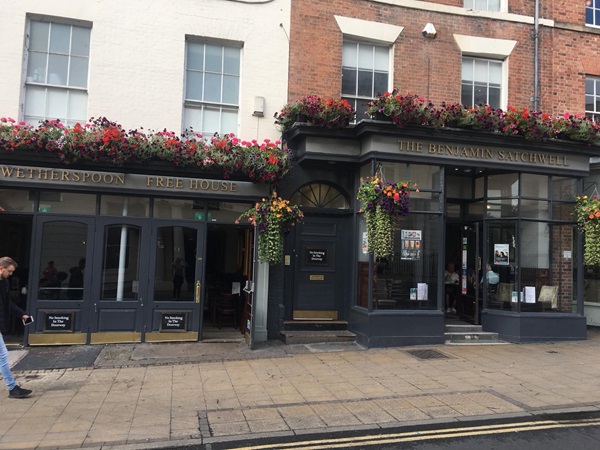
If you have information on the history of this pub, then we’d like you to share it with us. Please e-mail all information to: pubhistories@jdwetherspoon.co.uk